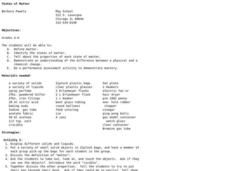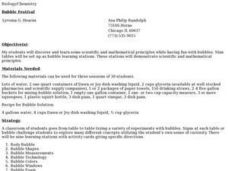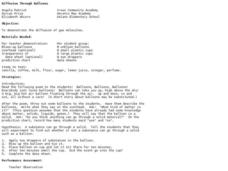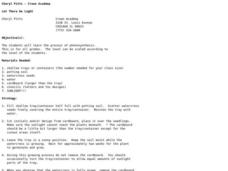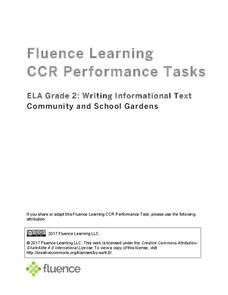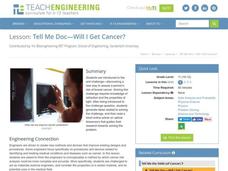Curated OER
A Guinea Pig Makes An Excellent Classroom Pet
Third graders live alongside guinea pigs. In this biology lesson plan, 3rd graders gain direct knowledge of the guinea pig's behavior and determine if it will make a good classroom pet.
Curated OER
Indoor Gardening
Students determine how a plant grows best. In this botany lesson, students observe variables that affect plant growth. Students explore how to grow and maintain a plant. Students make observations of their plant as it grows.
Curated OER
States of Matter
Students examine the properties of solids, liquids, and gasses. In this states of matter lesson plan, the teacher guides students through a series of experiments to illustrate each state of matter and how matter changes from one state...
Curated OER
Bubble Festival
Young scholars practice scientific inquiry while learning about bubbles. In this lesson about bubbles, students explore characteristics of bubbles. Young scholars move through nine different "bubble" stations following directions and...
Curated OER
Radiation Energy
Eighth graders experiment with a Geiger counter and a dosimeter to test the amount of radiation in a room and the amount of radiation received in a day. In this radiation energy lesson plan, 8th graders test the shielding effect of...
Curated OER
Composition of the Atom
Students investigate the structure of the atom and its composition. In this atom structure lesson, students find the area of cut out circles and drop pens into the circles. They count the number of marks in the circles and relate their...
Curated OER
Chemical Reaction Rates
High schoolers observe demonstrations to show factors that affect rates of chemical reactions. For this rates of chemical reactions lesson, students investigate how catalysts, reactant concentrations, temperature and surface area affect...
Curated OER
Evaporation and Temperature Change
Students investigate the relationship between evaporation and temperature changes. In this evaporation and changes in temperature lesson, students measure the changes in temperature of different solutions on a cotton ball.
Curated OER
Milk Glue
Young scholars observe a precipitation and neutralization reaction and learn to filter the products of the precipitation reaction. In this precipitation and neutralization lesson plan, students create curds and whey using milk and...
Curated OER
Diffusion Through Balloons
Students observe the diffusion of air molecules through a balloon. In this chemistry and molecules lesson, students fill balloons with air and a scented substance and observe whether the scented air is able to permeate the balloon.
Curated OER
Models of the Earth and Moon
Students explore the earth's rotation and phases of the moon. In this planets instructional activity, students rotate and revolve around a light representing the sun. Students use movement and props to simulate what causes the phases of...
Curated OER
Let There Be Light
Students plant seeds and learn about photosynthesis. In this photosynthesis lesson, students plant watercress seeds, cut a design into cardboard and cover the seedlings with the cardboard. Students observe as the seeds in the sunlight...
Curated OER
Moon Phases
Second graders understand that the visibility of the moon changes and that is called the moon phases. In this phases of the moon lesson, 2nd graders form a circle and create the phases. Students name the phase that matches their position...
Curated OER
I Did It!
Second graders choose a "positive work habit name" and explain why they choose the selected name. They share self-assessment information about their work habits and progress from week to week. Students respond with, "I did it" anytime...
Curated OER
Risk Taking Behaviors
Tenth graders listen to a presenters introduction and write questions they hope to have answered during the presentation. They listen to a presentation and record notes. They participate in small group discussion and complete...
Curated OER
Biology: Lung Capacity
Students perform experiments to determine their lung capacity and respiration rate. After choosing and performing one of two methods to discover lung capacity, they measure their respiratory rates and assess conditions that affect them....
Fluence Learning
Writing About Informational Text: Beyond the Beyond—Galaxies
Everyone has a different point of view, even when it comes to the enormity of the universe. Two separate text passages explain the scope of a galaxy, prompting young readers to write an essay about each author's argument and how the...
Fluence Learning
Writing a Narrative: How Bear Lost His Tail
After reading the first, second, and third parts of "How Bear Lost His Tail", third grade writers answer questions about the story by completing a series of options, including discussion points. Then, they begin to plan a new narrative...
Fluence Learning
Writing an Opinion: Is Pride Good or Bad?
Does pride really goeth before the fall, or can it be essential to one's development? Second graders read two of Aesop's fables that refer to pride in their morals, and write a short essay about whether pride is good or bad, based on...
Fluence Learning
Writing About Informational Text: Political Parties
To demonstrate their ability to craft an analysis of informational text, class members read excerpts from James Madison's "The Federalist No. 10," from George Washington's Farewell Address, and from Thomas Jefferson's First Inaugural...
Fluence Learning
Writing a Narrative: Two Frogs
Three options offer young writers the opportunity to read a short story, answer questions, and write a response. A handy language arts resource focuses on reading comprehension and analyziing the story's lesson: look before you leap.
Fluence Learning
Writing Informational Text: Community and School Gardens
Two informational texts feature community gardens of the past and present and how seeds grow. Scholars read, discuss what they have read, complete a timeline, define words, and compose a brief essay about the texts' main idea.
Teach Engineering
Energy Basics
Power up your lessons with an energetic resource. Scholars learn about work, force, energy, and power. They consider the relationships between these quantities through hockey puck scenarios and make calculations using formulas.
Teach Engineering
Tell Me Doc—Will I Get Cancer?
Can you beat the odds of cancer? In the first installment of a seven-part series, future biomedical engineers consider how to detect and diagnose cancer. An article on biosensors provides useful information toward this goal.




